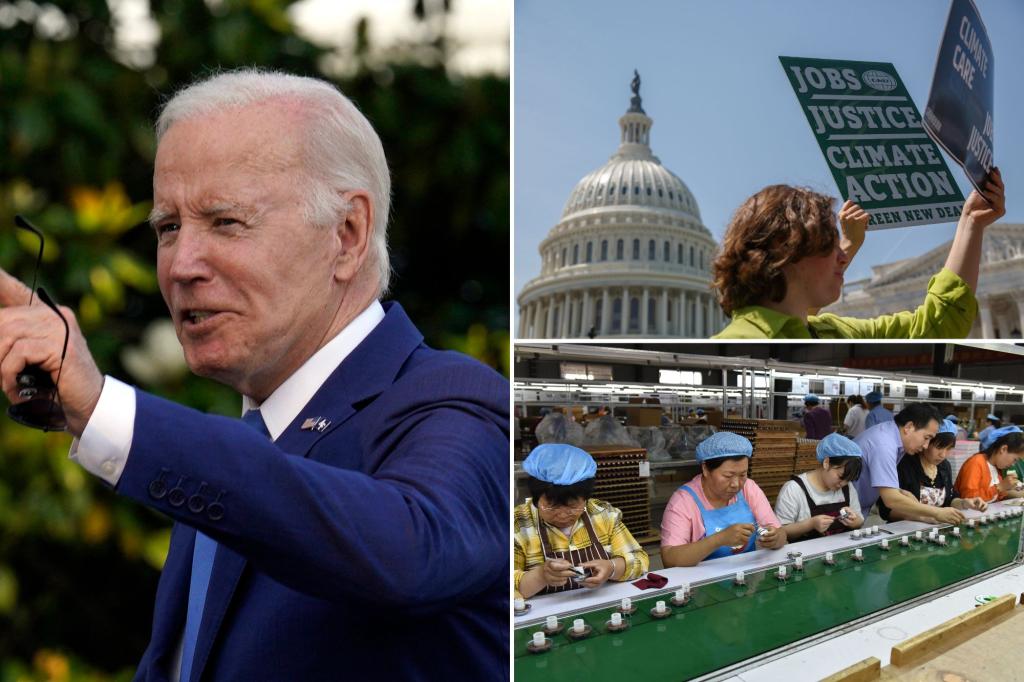This round of the debt-ceiling debate has been laid to rest.
The Biden administration is taking a victory lap.
The progressive left complains about spending cuts, and the conservative right is frustrated that the public debt continues to balloon.
One aspect of the debate, however, never came to public view: the victory of the green blob over effective industrial policy.
It’s no secret that America’s manufacturing sector has seen better days.
In 1970, manufacturing made up almost 25% of the economy. Today it makes up just over 10%.
Some of this is thanks to better technology, meaning that manufacturing companies can do more with less.

But a good deal of it is due to America outsourcing its manufacturing to China, where wages are lower.
The Rust Belt is rusting for a reason.
The flip side of America’s manufacturing decline is its increasing reliance on China for many goods.
The days when the only stuff on the shelves from China was found in the dollar store are long gone.

Today the main imports from China are electronics, such as laptops and smartphones, and heavy machinery used everywhere from factories to construction sites.
It’s not too much of an exaggeration to say that if trade with China ceased tomorrow — say, due to conflict over Taiwan — huge sections of the American economy would collapse as key supply chains seized up.
Nor is the American military immune.
The US fifth-generation F-35 fighter jets, for example, have recently been found to contain magnets in their turbomachine pumps that are imported from China.
In a conflict scenario, it’s unclear if these components could be serviced.
This doesn’t even consider the amount of basic goods and materials imported from China that go into various bits of military kit.
When the Biden administration announced its Inflation Reduction Act last year, many of those concerned with these trends breathed a sigh of relief.
Here was a piece of industrial-policy legislation that might fix the problem by supporting key parts of American industry through subsidies and tax credits.
At first glance, the IRA looked promising. The bill allocated $39 billion to the extremely important American semiconductor industry.
It allowed for an additional $24 billion in other manufacturing subsidies.
On closer inspection, however, it quickly became clear the bill was a dud.

For every $1 invested in industrial policy, it forked over $6 in the form of green-energy subsidies.
The IRA is not a piece of industrial policy but rather the infamous Green New Deal repackaged and rebranded.
The IRA is like a magician’s trick.
While the audience is distracted by the promises of rejuvenating American manufacturing, the magician pulls a $369 billion check out from behind the ear of the green lobbyists and hands it to them.
Because all the money is being spent on Big Green, there are only pennies left to be tossed at actual industry.
Economists call this “crowding out.” This is when money needed in one sector is no longer available because it is sucked up by another.
Three in the bed and the green lobbyists say “Roll over” — and they keep saying “Roll over” until everyone has fallen out of the bed except the green lobbyists.
GOP congressmen sensed the IRA was indeed a handout to Big Green and attacked it during the debt-ceiling debate.
But they had no alternative vision because they don’t yet understand the importance of industrial policy.
So instead they pushed for amendments to the bill that would help the fossil-fuel industry.
While this may be laudable on its own terms, it distracts from the much more pressing problems with trade and manufacturing the IRA was supposed to address.
Republicans need a coherent vision of industrial policy.
The Democrats have expressed interest but are too dependent, too addicted, to the Big Green slush fund.
They’re completely seduced by the sector’s extensive lobbying efforts inside the Beltway.
This carves out a space for Republicans to be the adults in the room and articulate a vision for an industrial policy that can strengthen the American economy.
There is a time and a place to highlight the importance of fossil fuels and the sometimes-false promises of green energy.
But the real fight is not so much between solar and fracking as it is between Big Green and the American economy’s capacity to produce the things it needs to be self-sustaining.
If the greedy green blob absorbs all the available funds, American industry will continue its steady, dreary decline.
Philip Pilkington is a macroeconomist and investment professional.
𝗖𝗿𝗲𝗱𝗶𝘁𝘀, 𝗖𝗼𝗽𝘆𝗿𝗶𝗴𝗵𝘁 & 𝗖𝗼𝘂𝗿𝘁𝗲𝘀𝘆: nypost.com
𝗙𝗼𝗿 𝗮𝗻𝘆 𝗰𝗼𝗺𝗽𝗹𝗮𝗶𝗻𝘁𝘀 𝗿𝗲𝗴𝗮𝗿𝗱𝗶𝗻𝗴 𝗗𝗠𝗖𝗔,
𝗣𝗹𝗲𝗮𝘀𝗲 𝘀𝗲𝗻𝗱 𝘂𝘀 𝗮𝗻 𝗲𝗺𝗮𝗶𝗹 𝗮𝘁 dmca@enspirers.com


